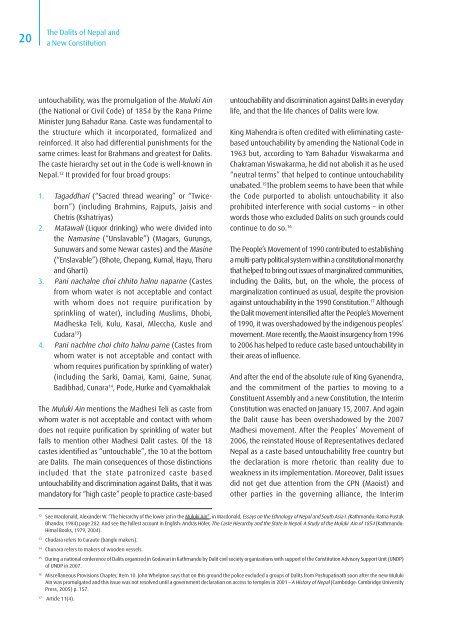The Dalits of Nepal and a New Constitution - ConstitutionNet
The Dalits of Nepal and a New Constitution - ConstitutionNet
The Dalits of Nepal and a New Constitution - ConstitutionNet
You also want an ePaper? Increase the reach of your titles
YUMPU automatically turns print PDFs into web optimized ePapers that Google loves.
20<br />
<strong>The</strong> <strong>Dalits</strong> <strong>of</strong> <strong>Nepal</strong> <strong>and</strong><br />
a <strong>New</strong> <strong>Constitution</strong><br />
untouchability, was the promulgation <strong>of</strong> the Muluki Ain<br />
(the National or Civil Code) <strong>of</strong> 1854 by the Rana Prime<br />
Minister Jung Bahadur Rana. Caste was fundamental to<br />
the structure which it incorporated, formalized <strong>and</strong><br />
reinforced. It also had differential punishments for the<br />
same crimes: least for Brahmans <strong>and</strong> greatest for <strong>Dalits</strong>.<br />
<strong>The</strong> caste hierarchy set out in the Code is well-known in<br />
<strong>Nepal</strong>. 12 It provided for four broad groups:<br />
1. Tagaddhari (“Sacred thread wearing” or “Twiceborn”)<br />
(including Brahmins, Rajputs, Jaisis <strong>and</strong><br />
Chetris (Kshatriyas)<br />
2. Matawali (Liquor drinking) who were divided into<br />
the Namasine (“Unslavable”) (Magars, Gurungs,<br />
Sunuwars <strong>and</strong> some <strong>New</strong>ar castes) <strong>and</strong> the Masine<br />
(“Enslavable”) (Bhote, Chepang, Kumal, Hayu, Tharu<br />
<strong>and</strong> Gharti)<br />
3. Pani nachalne choi chhito halnu naparne (Castes<br />
from whom water is not acceptable <strong>and</strong> contact<br />
with whom does not require purification by<br />
sprinkling <strong>of</strong> water), including Muslims, Dhobi,<br />
Madheska Teli, Kulu, Kasai, Mleccha, Kusle <strong>and</strong><br />
Cudara 13 )<br />
4. Pani nachlne choi chito halnu parne (Castes from<br />
whom water is not acceptable <strong>and</strong> contact with<br />
whom requires purification by sprinkling <strong>of</strong> water)<br />
(including the Sarki, Damai, Kami, Gaine, Sunar,<br />
Badibhad, Cunara 14 , Pode, Hurke <strong>and</strong> Cyamakhalak<br />
<strong>The</strong> Muluki Ain mentions the Madhesi Teli as caste from<br />
whom water is not acceptable <strong>and</strong> contact with whom<br />
does not require purification by sprinkling <strong>of</strong> water but<br />
fails to mention other Madhesi Dalit castes. Of the 18<br />
castes identified as “untouchable”, the 10 at the bottom<br />
are <strong>Dalits</strong>. <strong>The</strong> main consequences <strong>of</strong> those distinctions<br />
included that the state patronized caste based<br />
untouchability <strong>and</strong> discrimination against <strong>Dalits</strong>, that it was<br />
m<strong>and</strong>atory for “high caste” people to practice caste-based<br />
untouchability <strong>and</strong> discrimination against <strong>Dalits</strong> in everyday<br />
life, <strong>and</strong> that the life chances <strong>of</strong> <strong>Dalits</strong> were low.<br />
King Mahendra is <strong>of</strong>ten credited with eliminating castebased<br />
untouchability by amending the National Code in<br />
1963 but, according to Yam Bahadur Viswakarma <strong>and</strong><br />
Chakraman Viswakarma, he did not abolish it as he used<br />
“neutral terms” that helped to continue untouchability<br />
unabated. 15 <strong>The</strong> problem seems to have been that while<br />
the Code purported to abolish untouchability it also<br />
prohibited interference with social customs – in other<br />
words those who excluded <strong>Dalits</strong> on such grounds could<br />
continue to do so. 16<br />
<strong>The</strong> People’s Movement <strong>of</strong> 1990 contributed to establishing<br />
a multi-party political system within a constitutional monarchy<br />
that helped to bring out issues <strong>of</strong> marginalized communities,<br />
including the <strong>Dalits</strong>, but, on the whole, the process <strong>of</strong><br />
marginalization continued as usual, despite the provision<br />
against untouchability in the 1990 <strong>Constitution</strong>. 17 Although<br />
the Dalit movement intensified after the People’s Movement<br />
<strong>of</strong> 1990, it was overshadowed by the indigenous peoples’<br />
movement. More recently, the Maoist insurgency from 1996<br />
to 2006 has helped to reduce caste based untouchability in<br />
their areas <strong>of</strong> influence.<br />
And after the end <strong>of</strong> the absolute rule <strong>of</strong> King Gyanendra,<br />
<strong>and</strong> the commitment <strong>of</strong> the parties to moving to a<br />
Constituent Assembly <strong>and</strong> a new <strong>Constitution</strong>, the Interim<br />
<strong>Constitution</strong> was enacted on January 15, 2007. And again<br />
the Dalit cause has been overshadowed by the 2007<br />
Madhesi movement. After the Peoples’ Movement <strong>of</strong><br />
2006, the reinstated House <strong>of</strong> Representatives declared<br />
<strong>Nepal</strong> as a caste based untouchability free country but<br />
the declaration is more rhetoric than reality due to<br />
weakness in its implementation. Moreover, Dalit issues<br />
did not get due attention from the CPN (Maoist) <strong>and</strong><br />
other parties in the governing alliance, the Interim<br />
12<br />
See Macdonald, Alex<strong>and</strong>er W. “<strong>The</strong> hierarchy <strong>of</strong> the lower jat in the Muluki Ain”, in Macdonald, Essays on the Ethnology <strong>of</strong> <strong>Nepal</strong> <strong>and</strong> South Asia I. (Kathm<strong>and</strong>u: Ratna Pustak<br />
Bh<strong>and</strong>ar, 1984) page 282. And see the fullest account in English: András Höfer, <strong>The</strong> Caste Hierarchy <strong>and</strong> the State in <strong>Nepal</strong>: A Study <strong>of</strong> the Muluki Ain <strong>of</strong> 1854 (Kathm<strong>and</strong>u:<br />
Himal Books, 1979, 2004).<br />
13<br />
Chudara refers to Curaute (bangle makers).<br />
14<br />
Chunara refers to makers <strong>of</strong> wooden vessels.<br />
15<br />
During a national conference <strong>of</strong> <strong>Dalits</strong> organized in Godavari in Kathm<strong>and</strong>u by Dalit civil society organizations with support <strong>of</strong> the <strong>Constitution</strong> Advisory Support Unit (UNDP)<br />
<strong>of</strong> UNDP in 2007.<br />
16<br />
Miscellaneous Provisions Chapter, Item 10. John Whelpton says that on this ground the police excluded a groups <strong>of</strong> <strong>Dalits</strong> from Pashupatinath soon after the new Muluki<br />
Ain was promulgated <strong>and</strong> this issue was not resolved until a government declaration on access to temples in 2001 – A History <strong>of</strong> <strong>Nepal</strong> (Cambridge: Cambridge University<br />
Press, 2005) p. 157.<br />
17<br />
Article 11(4).








![g]k fnsf blntx? / gofF ;+l jwfg](https://img.yumpu.com/49483602/1/184x260/gk-fnsf-blntx-goff-l-jwfg.jpg?quality=85)



![+ljwfg;ef, /fHosf]k'g](https://img.yumpu.com/41604075/1/184x260/-ljwfgef-fhosfkg.jpg?quality=85)




